Research Case Study: Manitoba Vital Statistics and Residential School Students
Introduction
The photo below was located in the records of the Soeurs de Saint-Joseph de Saint-Hyacinthe at the Société historique de Saint-Boniface by Digital Archivist Sarah Story. Noting the caption indicating that these three students were infected with tuberculosis, she sent a digital copy of the photo to our team. Research by Dr. Anne Lindsay revealed that all three of the boys in the photo - Elie Caribou, Joseph Michel, and Albert Linklater – died of tuberculosis as a result of their incarceration at the Sturgeon Landing Indian Residential School. None of the boys, however, died at the school itself. All three were treated for tuberculosis at Dynevor Indian Hospital. Two of the boys died at the hospital, and one died later at home.
This case study demonstrates that residential school students who died as a result of their incarceration sometimes passed away at locations other than the residential schools themselves. This impacts where the missing children are buried. The Manitoba Vital Statistics online database can be helpful in identifying the location of death.

Société historique de Saint-Boniface, Photographie de trois garçons - Elie Caribou, Albert Linklater et Joseph Michel, 1946, Soeurs de Saint-Joseph de Saint-Hyacinthe, SHSB 101963
Researching the lives and deaths of the Elie Caribou, Joseph Michel, and Albert Linklater as both residential school students and tuberculosis patients highlights:
- How closely intertwined the two state systems of Indian hospitals and Indian residential schools were in the 1940s, and
- The challenges to researching individual student-patient deaths and burials.
Specifically, the research process outlined below illustrates that Vital Statistics records can be an important part of searching for loved ones, but also that locating the necessary records in the Manitoba Vital Statistics online database can be challenging.

Predecessor to the Guy Hill Residential School at The Pas, the residential school at Sturgeon Landing began operated from 1926 to 1952, when it was destroyed by fire. That fall, pupils and most of the staff were moved to facilities in The Pas where they remained until Guy Hill Residential School was built on nearby Clearwater Lake in 1957. National Centre for Truth and Reconciliation, S-088.
The Deaths of Three Boys
Dr. Lindsay was surprised to find records that indicated that all three of the boys were treated at the Dynevor Indian Hospital. Prior to 1943, when residential school students from Sturgeon Landing (Guy Hill) Residential School were sent away for medical care they were generally transferred to the nearby St. Anthony’s Hospital at The Pas. Elie Caribou had been to St. Anthony’s on 3 December 1942. He was subsequently moved across the province to the Dynevor Indian Hospital near Selkirk even though he was so ill he was not expected to live long when he was transferred. He was admitted to Dynevor Hospital on 15 December 1942. In his notes for the school’s report on Elie Caribou’s death, Dr. Murray Campbell wrote that Elie Caribou “lived somewhat longer than was expected and died April 24th, 1943.”
We know less about Joseph Michel’s short life than we do about Elie Caribou’s. If the school wrote a report about Joseph Michel’s death, it has not survived. His residential school records tell us that he was seven years old, and apparently in good health when he entered the Sturgeon Landing school in 1942. He was still seven years old when he died three months later at the Dynevor Indian Hospital in January 1943.
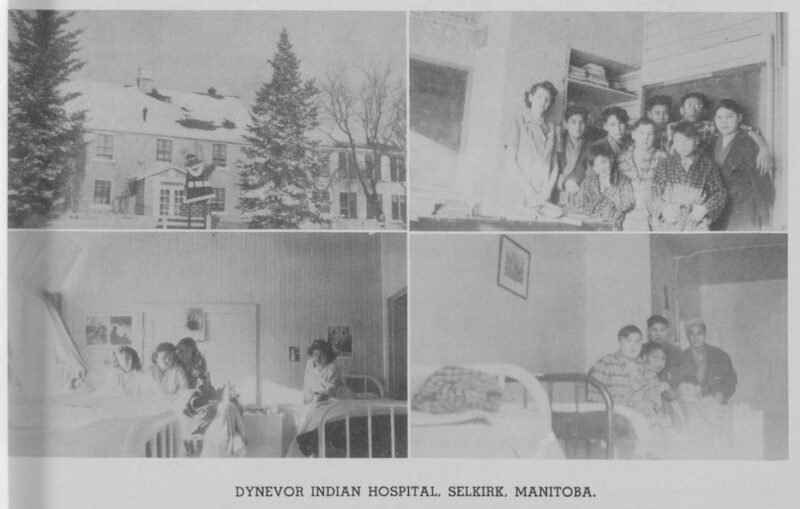
Dynevor Indian Hospital, Selkirk, Charles Camsell Indian Hospital Pictorial Review: Eighth Annual - 1955, CP 01-01-001
The third child in the photograph, Albert Linklater, was eight years old when he entered the Sturgeon Landing school in the summer of 1940. Like Elie Caribou and Joseph Michel, he was apparently well when he was admitted. Like Caribou and Michel, Albert Linklater soon fell ill with tuberculosis and was sent to the Dynevor Indian Hospital in 1941.
Unlike Caribou and Michel, however, Albert Linklater did not die at the Dynevor Hospital. Quarterly returns for the Sturgeon Landing school show that Linklater returned to the school on 19 April 1945. He remained there until 1947, when he was discharged on 15 August.
Here, the historical record becomes unclear. Linklater’s discharge form notes that he was “of age,” but also, possibly, that he died the next month (21 September 1947). Due to lack of clarity in the original record, it is possible that that the entry about dying at home refers to student Leo Saulteaux, whose name is listed below that of Linklater (see image below). The note in the school discharge form is ambiguous and could apply to either child. There is no death entry for either Linklater or Saulteaux in the Manitoba Vital Statistics online database that might clarify the entry.
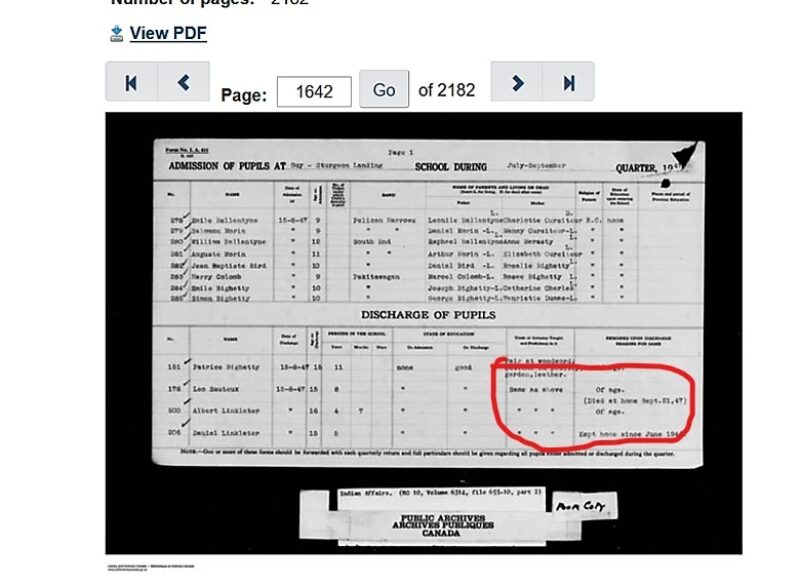
Although our team has requested vital statistics records that might indicate where Elie Caribou and Joseph Michel are buried, it may be months before our request will be fulfilled. In the meantime, the Archdiocese of Keewatin Le Pas has been able to confirm, by searching that community’s Catholic burial records, that Elie Caribou is buried in his home community of Pukatawagan.
1. Intersections between Residential Schools and Tuberculosis Treatment
If you think the family member who you are looking for may have attended a residential school, you might find their name in the National Student Memorial created by the National Centre for Truth and Reconciliation. As research on the Memorial is ongoing, is may not be complete or fully accurate.
Using this register to identify possible local burial sites can be complicated. As we have seen with Elie Caribou and Joseph Michel, the students listed in the NCTR’s National Student Memorial did not necessarily die at, or sometimes even near, the school they attended. Knowing where they died is important because where they died will almost certainly impact where they are buried. This is the case for Elie Caribou and may also be for Joseph Michel and Albert Linklater as well. We continue to research their deaths and burials.
Information about the deaths of Elie Caribou, Joseph Michel, and Albert Linklater are found in records held by Library and Archives Canada, and especially in the Department of Indian Affairs RG10 Schools Files.
2. Using the Manitoba Vital Statistics Online Database: Searching for Elie Caribou
As outlined in the Getting Started on Your Research section, most searches for missing patients will start with the Manitoba Vital Statistics online database. In Elie Caribou’s case, a search for his name spelled “Caribou” produced no results. Using a Wildcard Search, however, brought up three results. As shown below, the first of three results is the likely death record for Elie Caribou we are looking for.

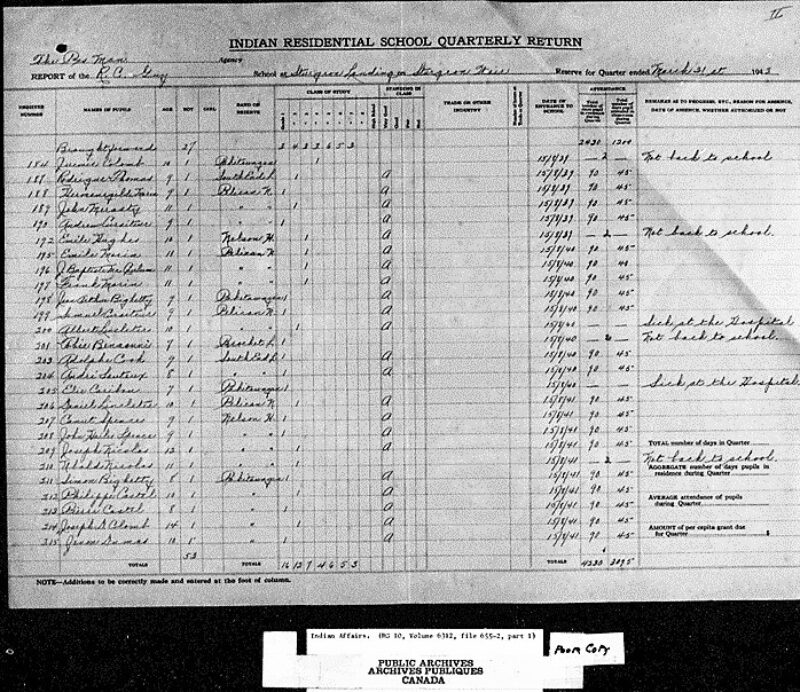
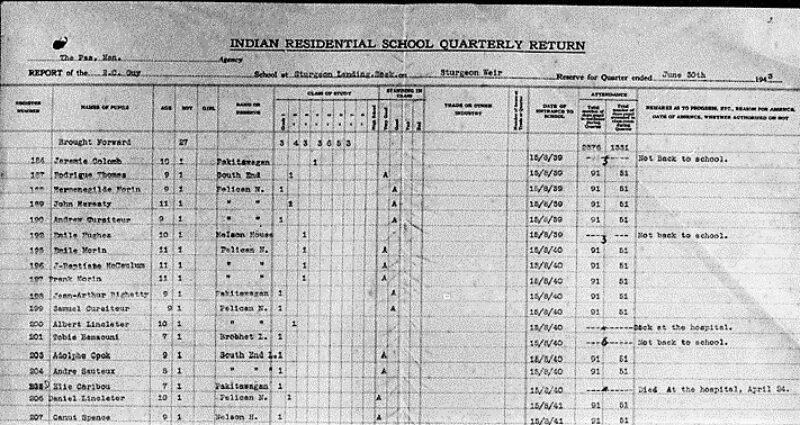
The online death record gives Elie's place of death as St. Andrew’s, Manitoba. We know that Elie attended St. Therese Indian Residential School at Sturgeon Landing on the Manitoba-Saskatchewan border, so why is his death listed as St. Andrew's, Manitoba? The answer is that Dynevor Indian Hospital was located in the rural municipality of St. Andrew's.
The next step after Vital Statistics is to look at the school files for the St. Therese/Sturgeon Landing/Guy Hill school(s) in the School Files at Library and Archives Canada using the Collection search.
In Collections search, we searched for “Guy Residential School” and then on the left-hand side of the page chose ‘Archives’ to limit to items from the archives only. Files with names like “Admissions and Discharges,” “Quarterly Returns,” and “Deaths of Pupils” may be the first places to look. Be sure to look at the dates the files cover to save time narrowing in.
Once you have identified a file you would like to look at, you can click on it, and look for information about:
- The microfilm [sometimes called 'container'] number
- The volume number
- The file number

The description for this record lists the information you are looking for:
Volume number: 631
Microfilm reel number: C-8690, C-8690
File number: 655-23, File part: 1
To make things a bit easier, rearrange this information to reflect the order in which you will use the information when accessing the Heritage Canadiana file:
Microfilm reel number: C-8690, Volume number: 6315, File number: 655-23, File part: 1
You can use this information to take you to search for microfilm C-8690 on Heritage Canadiana. From there, the files on the microfilm should be in order based first on their volume number, then on their file number.
When you find a page you are interested in, note the frame number. The link to these reels is to the first page, you will have to enter the frame number to get back to where you found the page.
There are also a few places that have digitized sections of the RG 10 schools files. Sometimes these online files have been curated for a specific purpose, so it is important to be sure you are looking at the entire file.
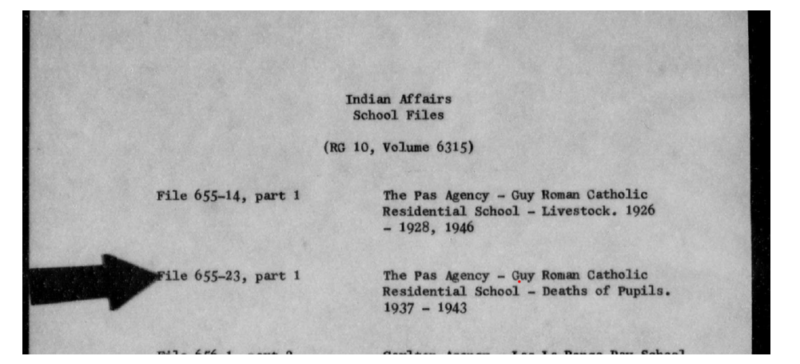
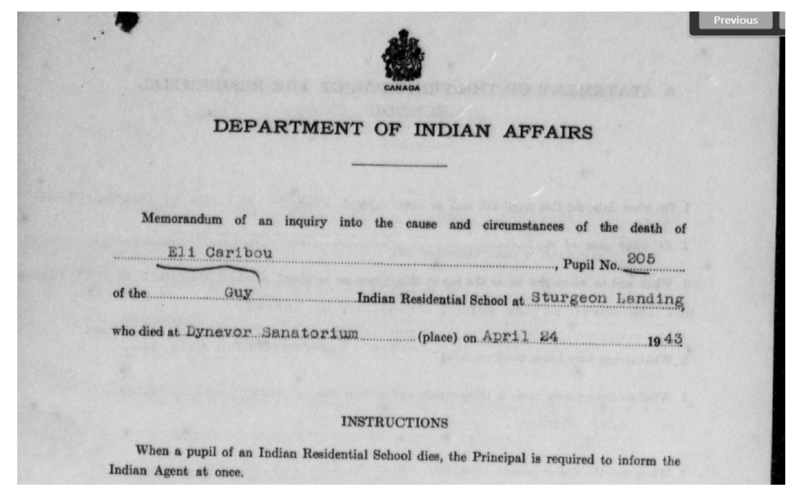
Eli Caribou, pupil #205, who died at Dynevor Indian Hospital 24 April 1943
Care: better food, rest, fresh air, etc.
Cod liver oil and cough mixture
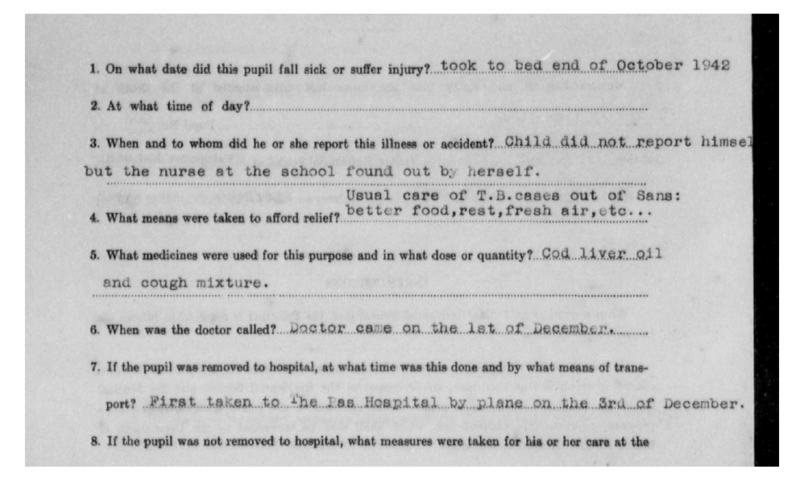
The doctor came on the first of December. Elie Caribou was first taken to The Pas Hospital by plane on the 3rd of December.

This child was admitted to Dynevor Hospital on December 15, 1942
Wide-spread active pulmonary Tuberculosis
He lived somewhat longer than was expected and died April 24th, 1943
But the file, and other schools files records we looked at do not say where Elie Caribou was buried. This is where a Vital Statistics record of a death can be helpful. It will include the place of death and may include the location of burial. While we are waiting for that record to arrive, we can continue to dig into the schools files to see if we can find out more about Elie Caribou, Joseph Michel, or Albert Linklater.
Elie Caribou died at a Sanatorium
The March 1943 Quarterly Returns for Sturgeon Lake Residential School (LAC RG10 Department of Indian Affairs School Files) indicate that Elie Caribou is “sick at the hospital.”
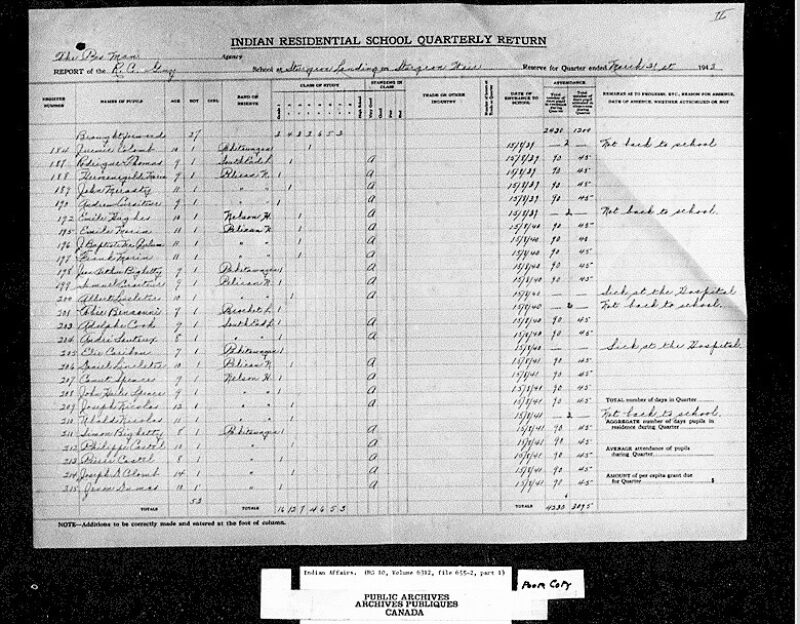
Note that Albert Linklater and Joseph Michel both appear in this same Quarterly Return.
The discharge records for Sturgeon Landing school (frame 1210) report that Elie Caribou “died, sanatorium, 24/4/43” and the subsequent quarterly report for the school indicates that Caribou “died at the hospital, April 24.”
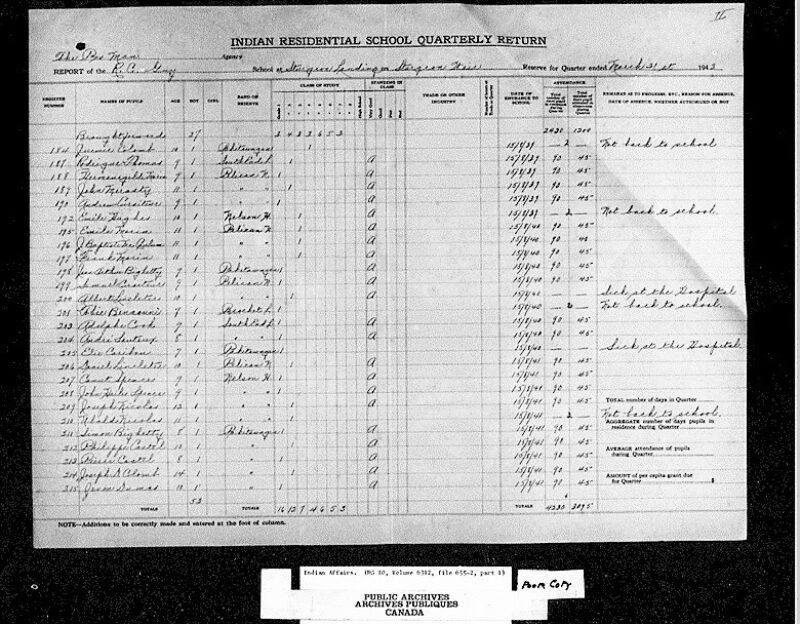
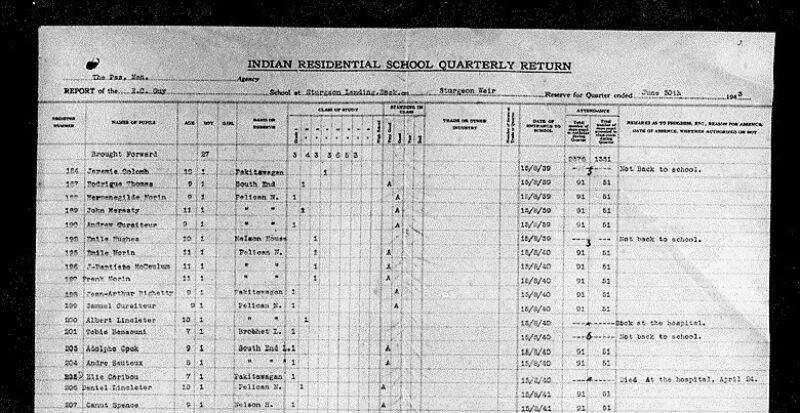
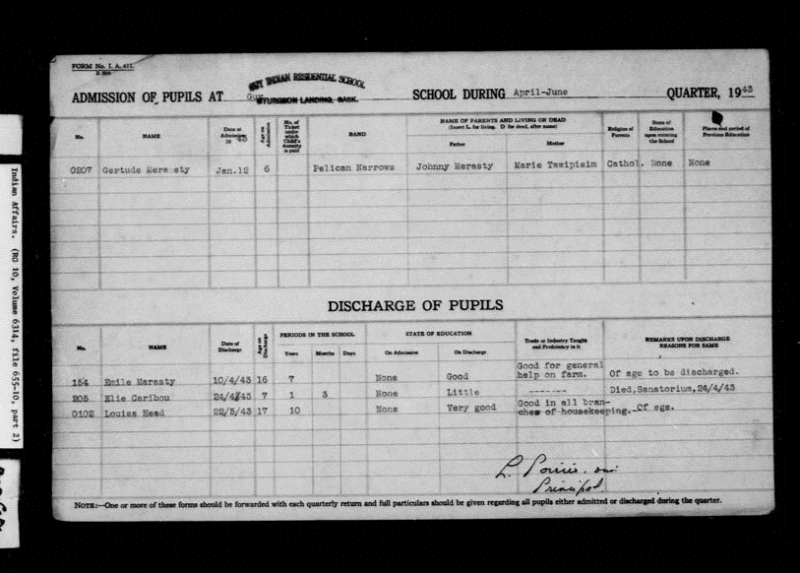
There is no indication that Caribou was relocated from Dynevor Indian Hospital to another care center, so although the name of the hospital is not indicated in these records, we proceed on the assumption that Caribou passed away at Dynevor Hospital on 24 April 1943. That is the information that we begin with in the search for his burial site.
Joseph Michel died at Dynevor Indian Hospital
We can find Joseph Michel’s name on the NCTR’s Memorial List for the Sturgeon Landing school. Admissions and Discharges and Quarterly Returns, as outlined above in Elie Caribou’s case, let us follow him from the school to the “sanatorium” and his January 1943 death “at the hospital.” In Joseph’s case, however, as in many others, the records only tell us that he was admitted to a TB hospital but not to which specific hospital he was transferred. We can, however, search for his death record in the Vital Statistics online database and order the full records.
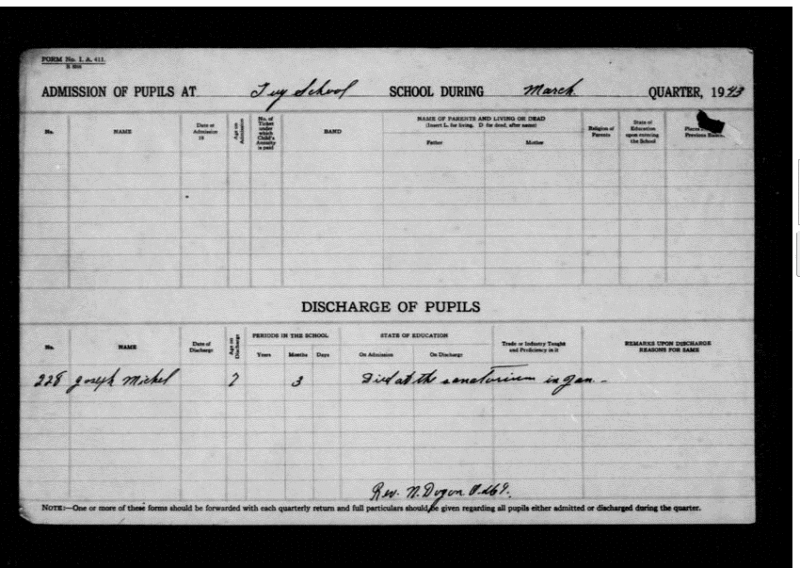
To learn more, we can use a wildcard search to find what is possibly the record of Joseph’s death as his last name is spelled “Michael” in the Vital Statistics database. We found the online record below, and ordered the full death record from Vital Statistics.

Joseph Michael, died 08 January 1943, St. Andrew’s, age 10
As with Elie Caribou, we can look for more schools records for Joseph Michel while we wait for the Vital Statistics record to arrive.
Look at the documents below. What do they tell us about Joseph Michel? When was he admitted to school? Did he have any siblings admitted at the same time? What was his state of health upon admission? What is the reason given for his discharge? Is his name spelled consistently in the documents? How might this impact how you search for him in the records?
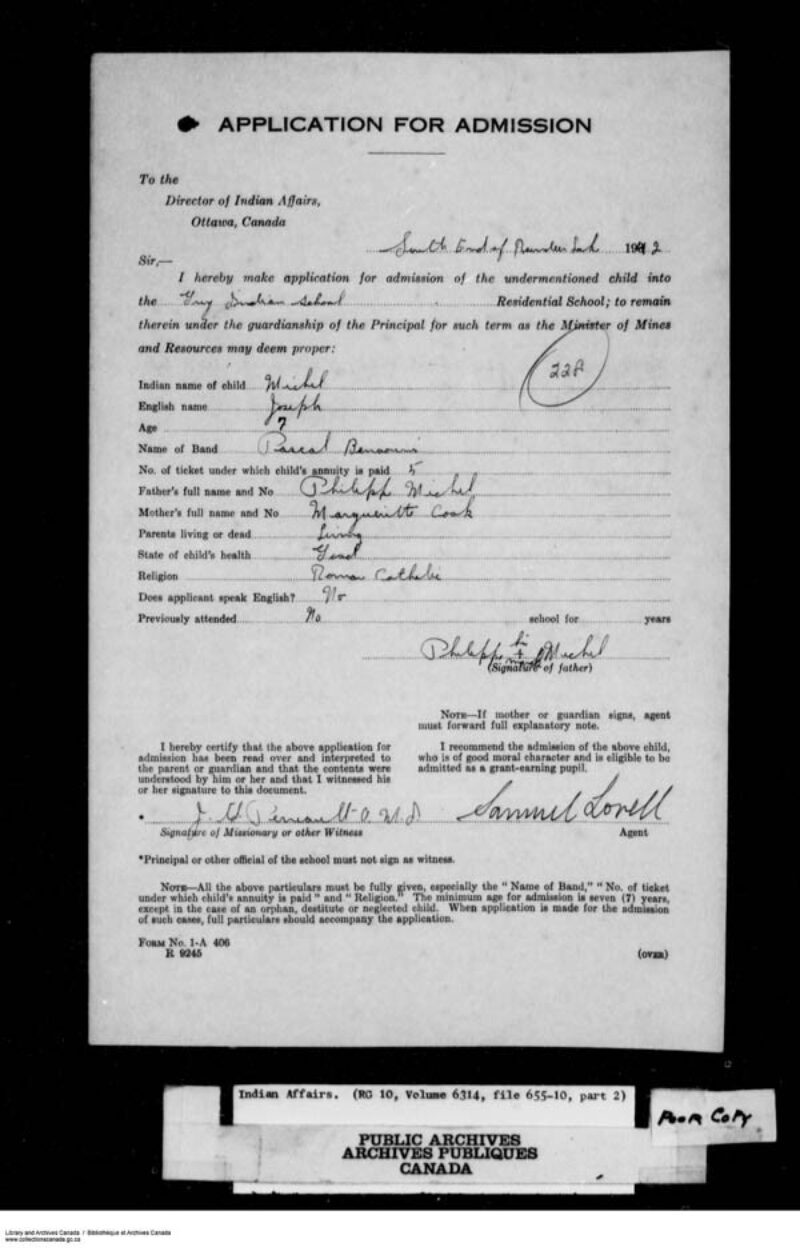

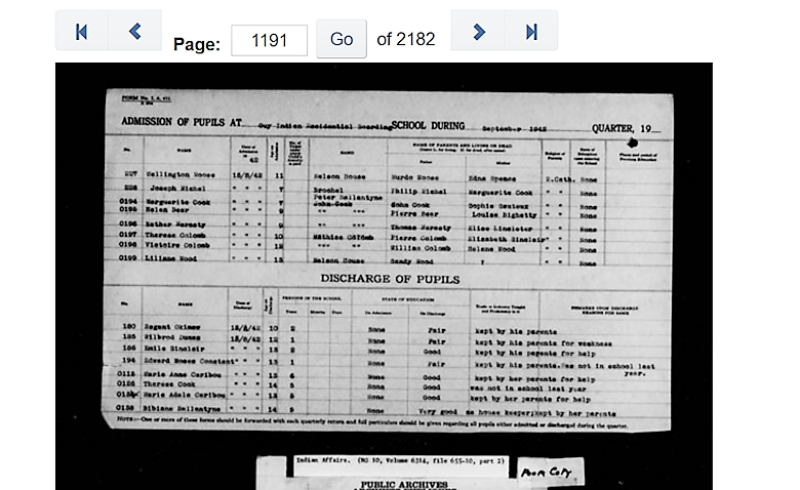
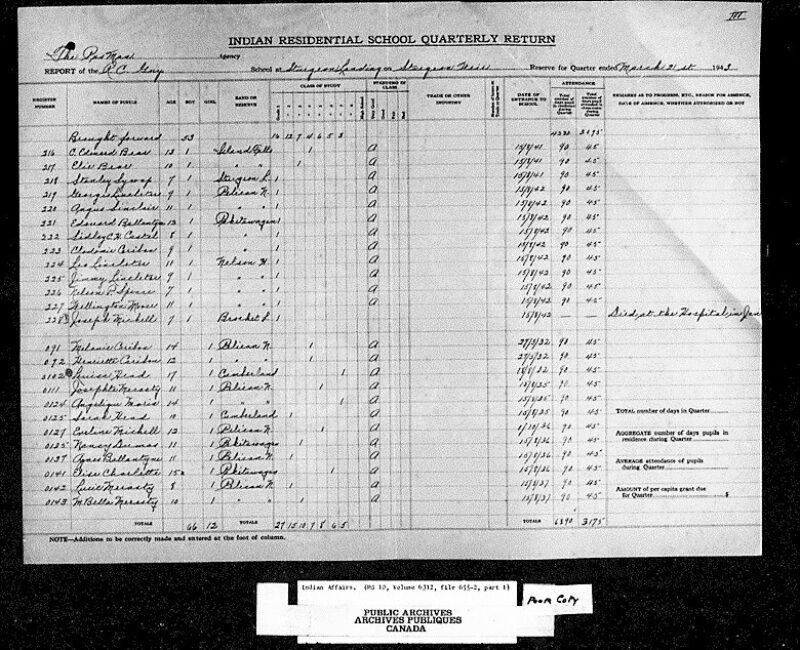
The admission application and record of admission above above tell us that Joseph Michel was age 7 when he was admitted to the 'Guy Indian School' (Sturgeon Landing Indian Residential School) on 15 August 1942. The note about health indicates that he had a skin infection that was expected to clear up in a few days, but no other health concerns.
The March 1943 Quarterly Return records state that Joseph died 'at hospital' in January 1943. The discharge record below confirms this date, shows that he was still only 7 years old, and notes that he 'died at the sanatorium.'
The name of the hospital is not given in any of these records, but since his online Vital Statistics death record indicates that he died at St. Andrew's, we can make a confident assumption that he died at Dynevor Indian Hospital. We can confirm this information when his full death record arrives from Vital Statistics.
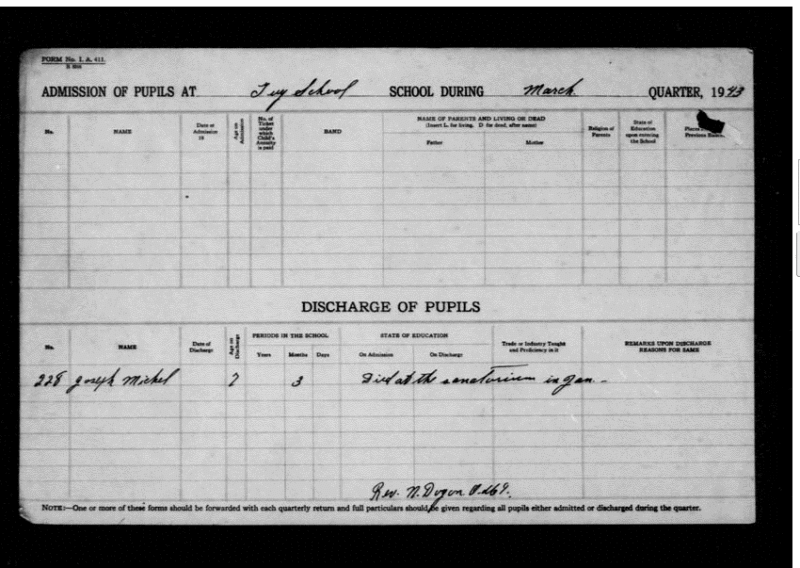
Albert Linklater died at home
Albert Linklater was also sent to Dynevor Indian Hospital, but he eventually returned to school. Falling ill again, he was sent home, where he passed away.
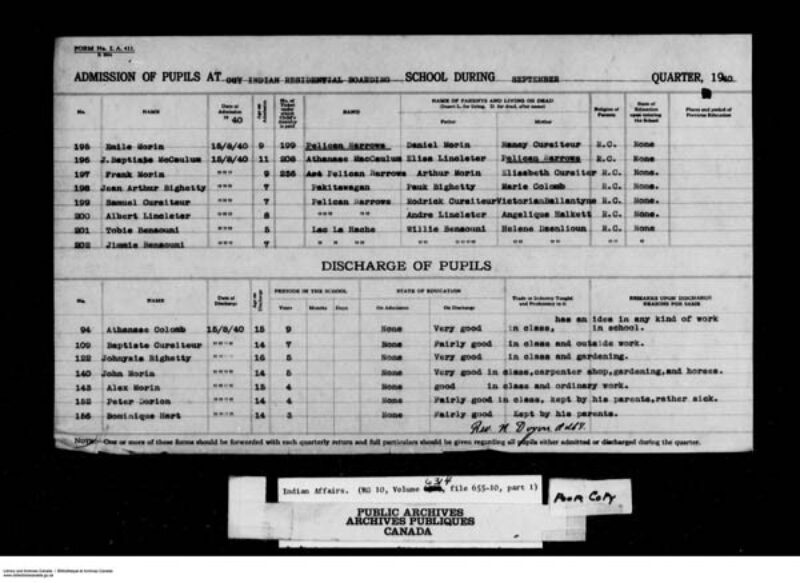
Admissions and Discharges, September 1960, Guy Indian Residential Boarding School, RG 10 vol. 6314 file 655-80, part I, Library and Archives Canada. Frame 1051
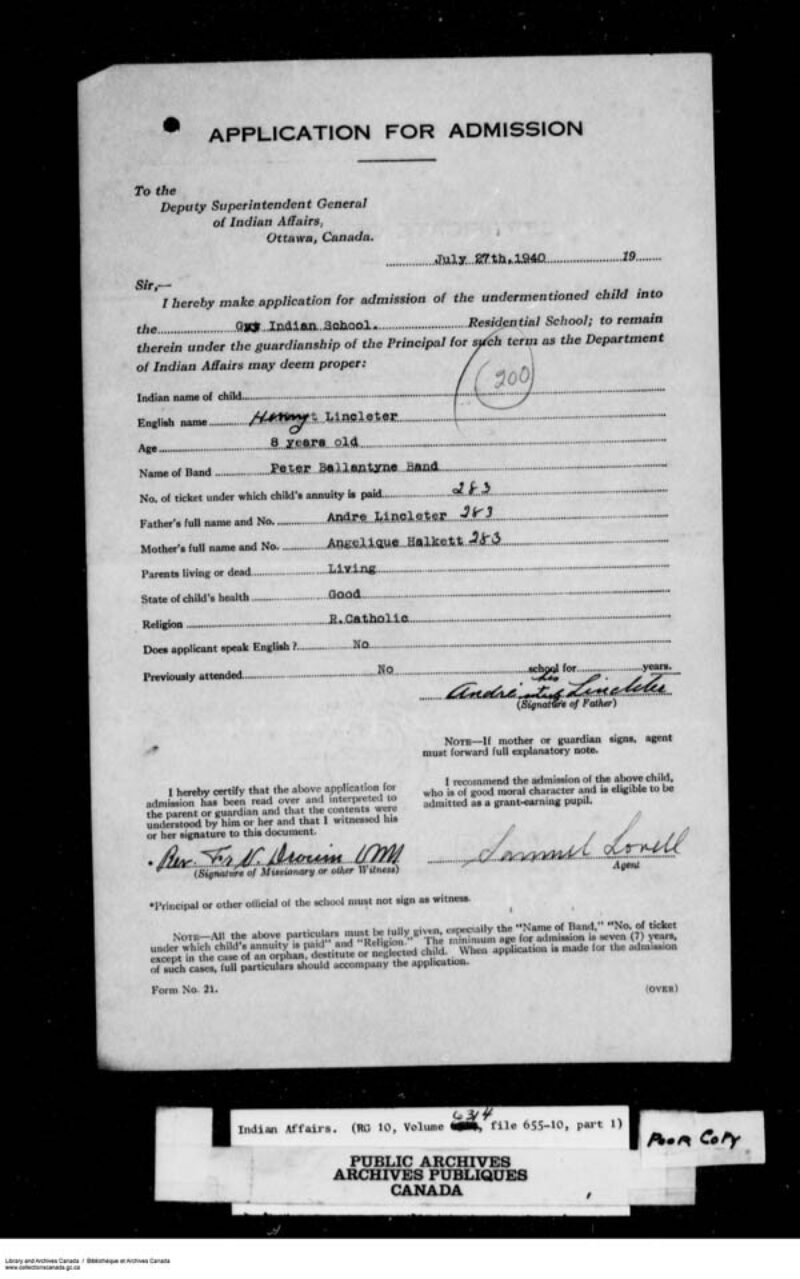
The Pas Agency - GUY ROMAN CATHOLIC RESIDENTIAL SCHOOL - ADMISSIONS - DISCHARGES, Library and Archives Canada, RG 10 vol 6314 file 655-10, file part: 1, Microfilm reel number: C-8689, frame 1006
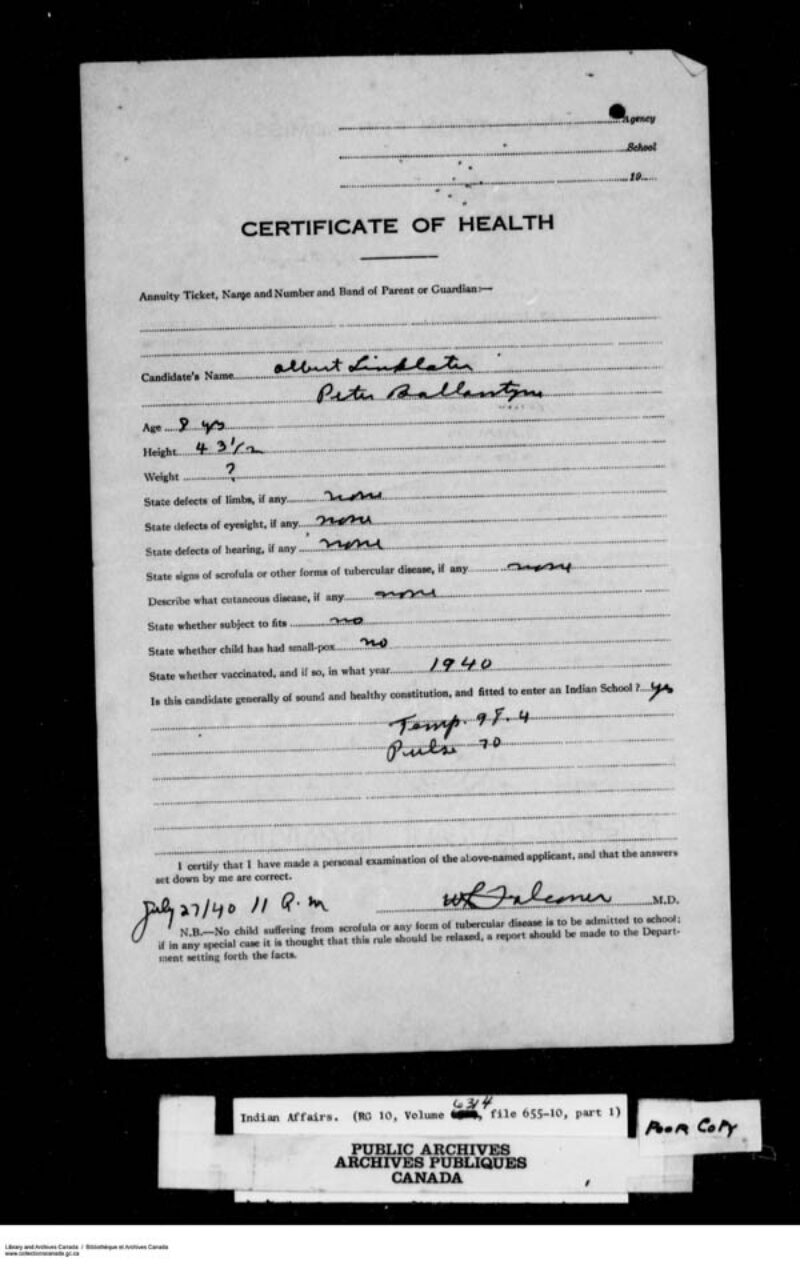
The Pas Agency - GUY ROMAN CATHOLIC RESIDENTIAL SCHOOL - ADMISSIONS - DISCHARGES, Library and Archives Canada, RG 10 vol 6314 file 655-10, file part: 1, Microfilm reel number: C-8689, frame 1007
Quarterly Returns show Albert Linklater, number 200, at the “Sanatorium” from 1941 [the earliest Quarterly Records we could find] until the end of the March quarter, 1945.

Arrived from Sanatorium 19-4-45
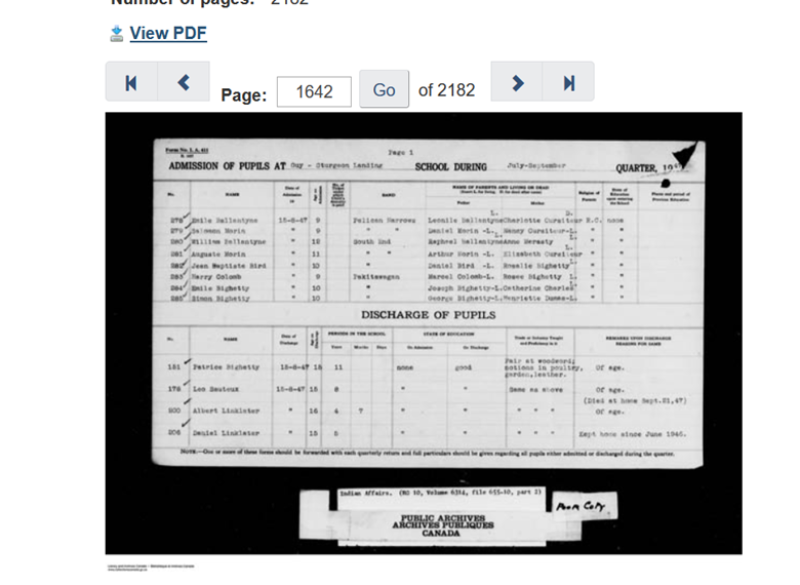
Albert Linklater died at home shortly after being discharged from school in 1947.

